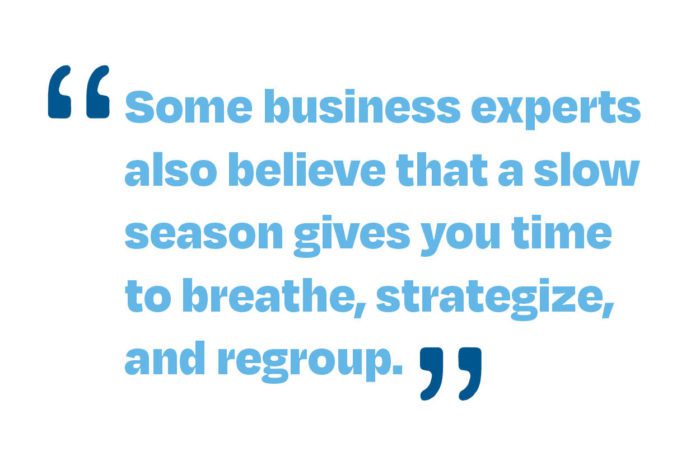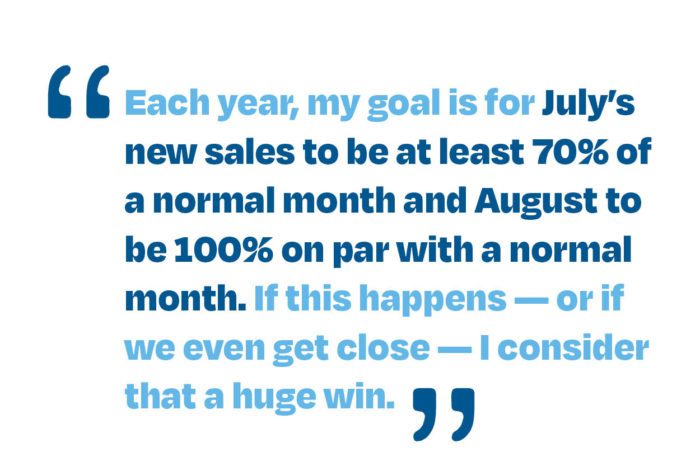Traditionally, summer is a slow season for new sales in the business-to-business world, and this particular downturn is usually at its worst in July. There are many factors that contribute to slow business months. Most families take trips with their kids, while others leave for quiet vacations with their spouses. And some are just occupied at work because summer is their busy season. Regardless of the reason, it’s difficult for most B2B companies to generate new leads with the same practices that worked months earlier when business was steadily growing.

This problem isn’t unique to B2Bs; all businesses have a slow season. Yours may be around Christmastime or during winter, as more people retreat inside to escape the cold. No matter when it happens, no one enjoys it when sales are slow. And for new business owners, this downturn can cause panic.
Finding The Pattern
During my first few years in this business, I didn’t realize that midsummer slow business months were a pattern for my industry. July would hit, and I’d be in full-on panic mode by mid-month. I was running around like Chicken Little, preaching about falling skies and driving my team crazy. When you put so much of yourself into a business, it’s heartbreaking to watch a sudden downfall — until you understand cycles. Now that I recognize this slowdown is just a seasonal issue, I’m left with two choices: Give up or push harder.
There are varying schools of thought on this topic that I’ve heard from some really intelligent professionals. Part of me thinks taking action during a slow season comes down to budget and desire for growth, but there isn’t a right or wrong answer. What works for one entrepreneur may not work for another. To find your solution to a budding slow season, all you have to do is use the savvy and expertise that got you this far.
Ways To Respond
How you respond to slow business months will depend on your business. For some, the answer may lie in preparing for the uptick in business around the corner; for others, it involves finding ways to improve their overall business strategy.
Personally, my solution is to dig deeper. If you’re like me and want to improve your sales when they normally dip, there is no shortage of strategies to do so. Here are just a few of my favorites.
Try Freemiums.
Even if no one wants to buy right now, people still love free stuff. Freemiums are offers for free but limited products. They give customers a taste of what you can do for them while saving the best features for “premium” customers who upgrade to a paid service.

Just make sure your benefit proposition is clear to your customers. Providing too few features will cause them to tune out before they get hooked, and giving them too many will leave them unwilling to shell out for more. For these reasons, some businesses prefer to offer free trials instead, where customers can try the product without a fee but pay after a certain period to keep accessing it.
Ramp Up Your Social Media Presence.
The best thing about social media marketing is that it costs little. So, while finances might be tighter during your slow business months, you can still stay top of mind with your consumers when they are ready to buy again. Get creative and consider giveaways or contests that will spur engagement, generate buzz, and drive new leads to your business. You can also engage your followers by conducting surveys and polls to learn more about their wants. And don’t forget to promote your products’ features and boost your current offers.

Partner With Other Businesses.
Are there businesses in your industry that offer complimentary but not competitive products to those your company sells? Is there a local business that provides something totally different but serves your demographic? Partnering can benefit you both. For example, you might offer a free appetizer at a local restaurant with each $50 purchase, or your partner might promote a special discount for your business to their customers. There are countless ways to get more creative. Find allies, brainstorm, and see what you can come up with together.
Is A Slow Season Always A Bad Thing?
Every business is different, so there’s no magic bullet for making your slow business months busier. Seasonal trends are a natural part of business; we can’t eliminate them entirely. After all, you might be able to sell more ice cream in January this year than you did last year — but you’re unlikely to ever sell as much as you do in July.
That’s not necessarily a bad thing. After all, it’s an opportunity for some time off. And while entrepreneurs often decide to forgo vacations, they’re doing their business a disservice by not taking a break.
Some business experts also believe that a slow season gives you time to breathe, strategize, and regroup. A few courageous entrepreneurs even engineer a slow season to get off the treadmill of endless work and look at the bigger picture. You may be making fewer sales, but that doesn’t necessarily have to translate to doing less work. There are countless productive ways to spend your time.

Plan, Plan, Plan.
The way to grow your business isn’t by winging it. But when you’re busy trying to make your customers happy, it’s challenging to find time to look at the bigger picture. Your slow season is an opportunity to look at where you stand and what kinds of adjustments you need to make to grow in the future.
Start with your marketing plan. Is it working for you, or has your return on investment tanked over the past year? Use this time to crunch the numbers and seek out new models that work better. Further, when was the last time you updated your business plan? It may be time. Finally, take stock of where you’ve succeeded and failed over the past 12 months. The slow season is the perfect opportunity to consider and incorporate last year’s lessons into your strategy.
Make Upgrades And Updates.
Could your website use a refresh? Is the decor in your business starting to look dated? Your slow season is the perfect opportunity to make any virtual and physical updates to your business. Renovating during your busiest period is a recipe for disaster and reduced sales. So make improvements when there are fewer customers to “pardon your dust.” Further, there’s nothing like having a clean new digital presence to impress your customers when they decide they need your product again.
If you’ve tracked your busy and slow season, you know when you can expect business to pick back up. Be ready to greet them with a fresh face.
Improve Yourself.
You probably invest in your business all the time, but when was the last time you invested in yourself? A company is only as strong as its leader, and we all have room to grow. While things are a bit less hectic, it can be the ideal moment to further your education. Take a class, pick up some business books that have been gathering dust on your shelves, or hire a business coach who can expand your thinking and help you develop strategies for success. You’ll ultimately be a more well-rounded entrepreneur and will likely pick up leadership and money-making skills along the way.
In other words, if you play your cards right, a “slow season” can be as busy as ever — just in a different way. A slow season can benefit many businesses by providing the breathing room they need to improve.
But while it’s not the right tactic for everyone, I refuse to accept a sales slowdown without a fight.
My Decision
I’m always growth-minded, and I want to conquer the slow months. I know that with the cyclical nature of business, the results of our efforts may not be noticeable until business picks up again. For example, July typically reaps new sales that add up to about 30% of how much we sell during a normal month. August is better, but we still only make about 70% in sales comparatively. But we can’t wade through a slow month without any action. So, my theory is that we should push hard in July in hopes that some of that hard work will spill over into August. At that point, we can anticipate our sales growing.
Each year, my goal is for July’s new sales to be at least 70% of a normal month and August to be 100% on par with a normal month. If this happens — or if we even get close — I consider that a huge win.

Regardless of the numbers, as long as we are increasing sales during our slow month from year to year, I know we are doing something right. By making an effort during the slow turn of my business, I can see if we are taking steps in the right direction during a time when every move has to be calculated.
The Plan And The Logic
Despite best intentions and execution, we likely won’t make up for a slow month with a ton of new lead promotions. Many people simply aren’t paying attention. So, we still develop a few new lead promotions, but the bulk of our efforts are focused on people who are already on our list.

Here are the three main areas we focus on each slow season:
- Potential clients we have recently spoken to but who haven’t given us a yes or no
- Past hot leads who have grown cold
- Leads that need to be reengaged
By focusing on internal leads, we have a much better chance of closing a sale, since these potential clients already know, like, and trust us. Theoretically, they also have some interest in our products and services. And because of this downturn in new lead generation, we have the resources and focus to pursue leads that remain in limbo.
To some extent, this comes down to a numbers game. We have to reach out and sell hard to double the number of people we sell to during a normal month. But all the effort will have both a short-term (July) and long-term (the remainder of the year) payout.
Does It Work?
To be totally transparent, there is no guarantee that marketing will work. That’s the terrifying beauty of it. You will never know a strategy’s outcome until you use it. I have seen my peers put out crazy successful marketing during their traditionally slow months. In fact, I’ve even created some campaigns to provide that success. But as with any new marketing method, it involves a bit of trial and error, and there are no guaranteed results.
So will this push and grind with in-progress leads work for you? The truth is that I don’t know. But I do know that if I don’t get up and try something, there is one certainty I can bank on: having a slow month.
If you want to make your slow business months a little busier and more profitable, your business might benefit from our Retention Guide. Fill out the form below to get your free copy and learn how to keep your customers happy and engaged every month of the year.


Recent Comments